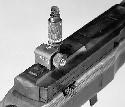

Springfield Armory Museum - Collection Record


Send us your own comments about this object.
| Title: | RIFLE, MILITARY - U.S. RIFLE T25 .30 (T65) SN# 1 |
| Maker/Manufacturer: | HARVEY, EARLE M. |
| Date of Manufacture: | 1948 |
| Eminent Figure: | |
| Catalog Number: | SPAR 3181 |
| Measurements: | OL:109.8CM 43 1/4" BL: 55.8CM 22" 7.5 lbs. without accessoires. |
Object Description:
U.S. RIFLE T25 .30 (T65) SN# 1
Manufactured by Bennel Machine Co., Brooklyn, N.Y. in 1948 - The T25 is a gas-operated (cut-off expansion), 20-round magazine fed, shoulder fire weapon capable of select-fire. Full automatic fire was performed in the open bolt position. Rifle is equipped with stabilizer and in-line stock to reduce recoil. Front sight mount and bayonet lug were integral with the flash suppressor as a separate unit from the gas system components. Aperture rear sight. Muzzle velocity of 2700 fps. Cyclic rate of fire 725 rpm. Weapon weighs 7.5 lbs. without accessories. The prototype T25s were designed for the new 49mm case, the FA-T1. This was the first rifle expressly designed for the new T65 "lightweight" cartridge. The first four T25 rifles were manufactured by the Bennel Machine Company. The T25 project was initiated in September 1945 and was terminated in November 1951.
Markings:
Receiver: RIFLE CALIBER .30 T25. HARVEY PATENT.
Select switch: REPEAT AUTO.
HISTORICAL SUMMARY OF ACTIVITIES:
1JUL51 - 31DEC51 - "During the period specified, Production Engineering made a complete study of the T-25 Rifle (current designation T-47). This study was instituted and directed by Production Engineering Branch through an outside engineering facility. The scope of the study included a complete re-analysis of the weapon with accompanying redesign for all of the major components. The aim was to achieve a design that was suitable for high production with penalizing function. The program was completed successfully."
Notes: "OBJECT: To ascertain that various windage and elevation settings of the subject sights do not change during prolonged firing.
SUMMARY: A T-25 Rifle rear sight assembly was tested on a Caliber .30, Browning Automatic Rifle, M1918A2, and on the Caliber .30 T-25 Rifle (SN# 1). No changes in elevation or windage setting due to firing occurred throughout the test." - SA-MR11-2033
"Bennel engineers first fired the T25 rifle, serial number 1, in a Manhattan National Guard Armory in January 1948. Results of the early tests with the Harvey rifle indicated that the weapon had above-average qualities in performance, effectiveness, and accuracy." - Edward Ezell
In initial testing at Aberdeen this rifle had excessive firing pin breakage, improper ejection patterns for expended cartridge cases, failures to feed from magazine, and limited reliability under Arctic conditions. Test did demonstrate that rifle was more accurate than the M1 for control purposes, and operated satisfactorily under adversed conditions. After testing, this weapon was returned to Springfield Armory for reconditioning.
After being reconditioned, and sent to Aberdeen for further testing on January 11-13, 1949, there were no parts failure and much less feeding problems.
This was to be the rifle the Ordnance Department put all its hopes on. By March of 1949, no other weapon was being seriously tested. "It simply boiled down to," wrote Edward Ezell, "the Harvey rifle or nothing."
"By 1950 the T25 rifle was so far advanced in development testing that plans were begun to procure five thousand rifles. However, at this point, the British requested that competitive tests be conducted between the T25 rifle and their EM2 rifle before ordering such a large number. This was agreed to by the U.S., and this seemed to mark of the peak for the T25, with its likelihood of adoption going down thereafter.
Comparative tests were conducted in 1950 at Fort Benning between the .30 caliber T25 rifle and two caliber .280 rifles submitted by the British; one the EM2 and the other the Belgian Fabrique Nationale (FN), tailored to meet British requirements. The outcome of these tests was that the board preferred the FN due to the simplicity of field stripping, but agreed on proceeding with correction of deficiencies in the T25 for future tests.
Corrections to the T25 growing out of the 1950 Fort Benning tests resulted in re-designation of the rifle to T47. The main change was to replace the in-line stock with a dropped-stock and lowering
See, Ezell, THE GREAT RIFLE CONTROVERSY, pp. 77, 82-83.
References:
Ezell, Edward C. THE GREAT RIFLE CONTROVERSY. Stackpole Books. Harrisburg, Pa. 1984.
Rayle, Roy E. RANDOM SHOTS: EPISODES IN THE LIFE OF A WEAPONS DEVELOPER. Merriam Press. Burlington, Vt. 1997.
Stevens, Blake. U.S. RIFLE M14 FROM JOHN GARAND TO THE M21. 2nd Ed. Collector Grade Publications. Toronto, Canada. 1991.
SA-MR11-2033. Test of Rear Sight Assembly for the Lightweight Rifle, Caliber .30, T25, by A. Fowler. Springfield, Ma., January 16, 1950.
SA-NM11-2030. Notes on Development Type Materiel for the Rifle, Caliber .30, T25, by H. Hawthorne. Springfield, Ma., December 29, 1948.